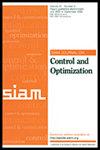使用事件传感器进行状态估计:可观测性分析与多传感器融合
IF 2.4
2区 数学
Q2 AUTOMATION & CONTROL SYSTEMS
引用次数: 0
摘要
SIAM 控制与优化期刊》第 62 卷第 1 期第 167-190 页,2024 年 2 月。 摘要本文研究了基于事件传感器极化测量信息的线性时不变系统的状态估计问题。为了能够设计估计器,本文定义了一个新的可观测性概念,即[math]-可观测性,其精度参数[math]与推断初始状态的最坏情况性能有关,并在此基础上制定了一个标准来测试离散时间线性系统的[math]-可观测性。利用来自事件传感器的多传感器极性数据和隐藏在无事件时刻事件触发条件中的隐含信息,设计了一种迭代事件触发状态估计器,以评估包含所有可能状态值的集合。所提出的估计器是通过对相交椭圆的外近似来建立的,这些椭圆是根据先前的状态估计和从接收到的事件传感器极性信息以及事件触发协议中推断出的椭圆来预测的;从多传感器事件测量中得出的状态估计区域被融合在一起,其大小被证明是渐进有界的。讨论了利用分层结构的双层处理器网络对估计算法进行分布式实施的问题,并分析了以集中和分布式方式实施的算法的时间计算复杂性。通过数值实验验证了所提出的事件触发状态估计器的效率。本文章由计算机程序翻译,如有差异,请以英文原文为准。
State Estimation with Event Sensors: Observability Analysis and Multi-sensor Fusion
SIAM Journal on Control and Optimization, Volume 62, Issue 1, Page 167-190, February 2024.
Abstract. This work investigates a state estimation problem for linear time-invariant systems based on polarized measurement information from event sensors. To enable estimator design, a new notion of observability, namely, [math]-observability is defined with the precision parameter [math] which relates to the worst-case performance of inferring the initial state, based on which a criterion is developed to test the [math]-observability of discrete-time linear systems. Utilizing multisensor polarity data from event sensors and the implicit information hidden in event-triggering conditions at no-event instants, an iterative event-triggered state estimator is designed to evaluate a set containing all possible values of the state. The proposed estimator is built by outer approximation of intersecting ellipsoids that are predicted from previous state estimates and the ellipsoids inferred from received polarity information of event sensors as well as the event-triggering protocol; the estimated regions of the state derived from multisensor event measurements are fused together, the sizes of which are proved to be asymptotically bounded. Distributed implementation of the estimation algorithm utilizing a two-layer processor network of hierarchy architecture is discussed, and the temporal computational complexity of the algorithm implemented in centralized and distributed ways is analyzed. The efficiency of the proposed event-triggered state estimator is verified by numerical experiments.
Abstract. This work investigates a state estimation problem for linear time-invariant systems based on polarized measurement information from event sensors. To enable estimator design, a new notion of observability, namely, [math]-observability is defined with the precision parameter [math] which relates to the worst-case performance of inferring the initial state, based on which a criterion is developed to test the [math]-observability of discrete-time linear systems. Utilizing multisensor polarity data from event sensors and the implicit information hidden in event-triggering conditions at no-event instants, an iterative event-triggered state estimator is designed to evaluate a set containing all possible values of the state. The proposed estimator is built by outer approximation of intersecting ellipsoids that are predicted from previous state estimates and the ellipsoids inferred from received polarity information of event sensors as well as the event-triggering protocol; the estimated regions of the state derived from multisensor event measurements are fused together, the sizes of which are proved to be asymptotically bounded. Distributed implementation of the estimation algorithm utilizing a two-layer processor network of hierarchy architecture is discussed, and the temporal computational complexity of the algorithm implemented in centralized and distributed ways is analyzed. The efficiency of the proposed event-triggered state estimator is verified by numerical experiments.
求助全文
通过发布文献求助,成功后即可免费获取论文全文。
去求助
来源期刊
CiteScore
4.00
自引率
4.50%
发文量
143
审稿时长
12 months
期刊介绍:
SIAM Journal on Control and Optimization (SICON) publishes original research articles on the mathematics and applications of control theory and certain parts of optimization theory. Papers considered for publication must be significant at both the mathematical level and the level of applications or potential applications. Papers containing mostly routine mathematics or those with no discernible connection to control and systems theory or optimization will not be considered for publication. From time to time, the journal will also publish authoritative surveys of important subject areas in control theory and optimization whose level of maturity permits a clear and unified exposition.
The broad areas mentioned above are intended to encompass a wide range of mathematical techniques and scientific, engineering, economic, and industrial applications. These include stochastic and deterministic methods in control, estimation, and identification of systems; modeling and realization of complex control systems; the numerical analysis and related computational methodology of control processes and allied issues; and the development of mathematical theories and techniques that give new insights into old problems or provide the basis for further progress in control theory and optimization. Within the field of optimization, the journal focuses on the parts that are relevant to dynamic and control systems. Contributions to numerical methodology are also welcome in accordance with these aims, especially as related to large-scale problems and decomposition as well as to fundamental questions of convergence and approximation.

 求助内容:
求助内容: 应助结果提醒方式:
应助结果提醒方式:


